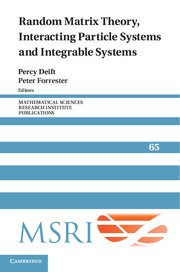Book contents
- Frontmatter
- Contents
- Preface
- Universality conjecture for all Airy, sine and Bessel kernels in the complex plane
- On a relationship between high rank cases and rank one cases of Hermitian random matrix models with external
- Riemann–Hilbert approach to the six-vertex model
- CLT for spectra of submatrices of Wigner random matrices, II: Stochastic evolution
- Critical asymptotic behavior for the Korteweg–de Vries equation and in random matrix theory
- On the asymptotics of a Toeplitz determinant with singularities
- Asymptotic analysis of the two-matrix model with a quartic potential
- Conservation laws of random matrix theory
- Asymptotics of spacing distributions 50 years later
- Applications of random matrix theory for sensor array imaging with measurement noise
- Convolution symmetries of integrable hierarchies, matrix models and τ-functions
- Universality limits via “old style” analysis
- Fluctuations and large deviations of some perturbed random matrices
- Three lectures on free probability
- Whittaker functions and relatedstochastic processes
- How long does it take to compute the eigenvalues of a random symmetric matrix?
- Exact solutions of the Kardar–Parisi–Zhang equation and weak universality for directed random polymers
- Replica analysis of the one-dimensional KPZ equation
- Asymptotic expansions for β matrix models and their applications to the universality conjecture
- KPZ scaling theory and the semidiscrete directed polymer model
- Experimental Realization Of Tracy–Widom Distributions And Beyond: Kpz Interfaces In Turbulent Liquid Crystal
- Random matrices: the four-moment theorem for Wigner ensembles
On a relationship between high rank cases and rank one cases of Hermitian random matrix models with external
Published online by Cambridge University Press: 29 May 2025
- Frontmatter
- Contents
- Preface
- Universality conjecture for all Airy, sine and Bessel kernels in the complex plane
- On a relationship between high rank cases and rank one cases of Hermitian random matrix models with external
- Riemann–Hilbert approach to the six-vertex model
- CLT for spectra of submatrices of Wigner random matrices, II: Stochastic evolution
- Critical asymptotic behavior for the Korteweg–de Vries equation and in random matrix theory
- On the asymptotics of a Toeplitz determinant with singularities
- Asymptotic analysis of the two-matrix model with a quartic potential
- Conservation laws of random matrix theory
- Asymptotics of spacing distributions 50 years later
- Applications of random matrix theory for sensor array imaging with measurement noise
- Convolution symmetries of integrable hierarchies, matrix models and τ-functions
- Universality limits via “old style” analysis
- Fluctuations and large deviations of some perturbed random matrices
- Three lectures on free probability
- Whittaker functions and relatedstochastic processes
- How long does it take to compute the eigenvalues of a random symmetric matrix?
- Exact solutions of the Kardar–Parisi–Zhang equation and weak universality for directed random polymers
- Replica analysis of the one-dimensional KPZ equation
- Asymptotic expansions for β matrix models and their applications to the universality conjecture
- KPZ scaling theory and the semidiscrete directed polymer model
- Experimental Realization Of Tracy–Widom Distributions And Beyond: Kpz Interfaces In Turbulent Liquid Crystal
- Random matrices: the four-moment theorem for Wigner ensembles
Summary
We prove an identity on Hermitian random matrix models with external source relating the high rank cases to the rank 1 cases. This identity was proved and used in a previous paper of ours to study the asymptotics of the top eigenvalues. In this paper, we give an alternative, more conceptual proof of this identity based on a connection between the Hermitian matrix models with external source and the discrete KP hierarchy. This connection is obtained using the vertex operator method of Adler and van Moerbeke. The desired identity then follows from the Fay-like identity of the discrete KP τvector.
1. Introduction
The subject of this paper is an identity between a Hermitian random matrix model with external source of rank m and m such models with external source of rank 1. This identity allows us to reduce the asymptotic study of “spiked Hermitian random matrix models” of rank higher than 1 to that of the models of rank 1. This reduction formula was used in [Baik andWang 2013] to evaluate the limiting fluctuations of the top eigenvalue(s) of spiked models of arbitrary fixed rank with a general class of potentials. In [Baik and Wang 2013] we gave a direct proof of this identity using the formula of [Baik 2009] on the Christoffel–Darboux kernel. Here we give a different, more conceptual proof using the relation between the random matrix model with external source and discrete KP hierarchy. We show how the general results of [Adler and van Moerbeke 1999] on the construction of solutions of discrete KP hierarchy can be used on the partition functions of the Hermitian matrix model with external source.
We now introduce the model. Let W(x) be a piecewise continuous function on ℝ. We assume that W(x) is nonnegative, has infinite support, and vanishes sufficiently fast as |x| → ∞ so that (3) converges. Let A be a d x d Hermitian matrix with eigenvalues a1, ..., ad . We call A the external source matrix and W(x) the weight function. Consider the following measure on the set Hd of d x d Hermitian matrix M:
where W(M) is defined in terms of a functional calculus and
is the partition function. Note that the partition function depends only on the eigenvalues of A, but not its eigenvectors.
Information
- Type
- Chapter
- Information
- Publisher: Cambridge University PressPrint publication year: 2014
